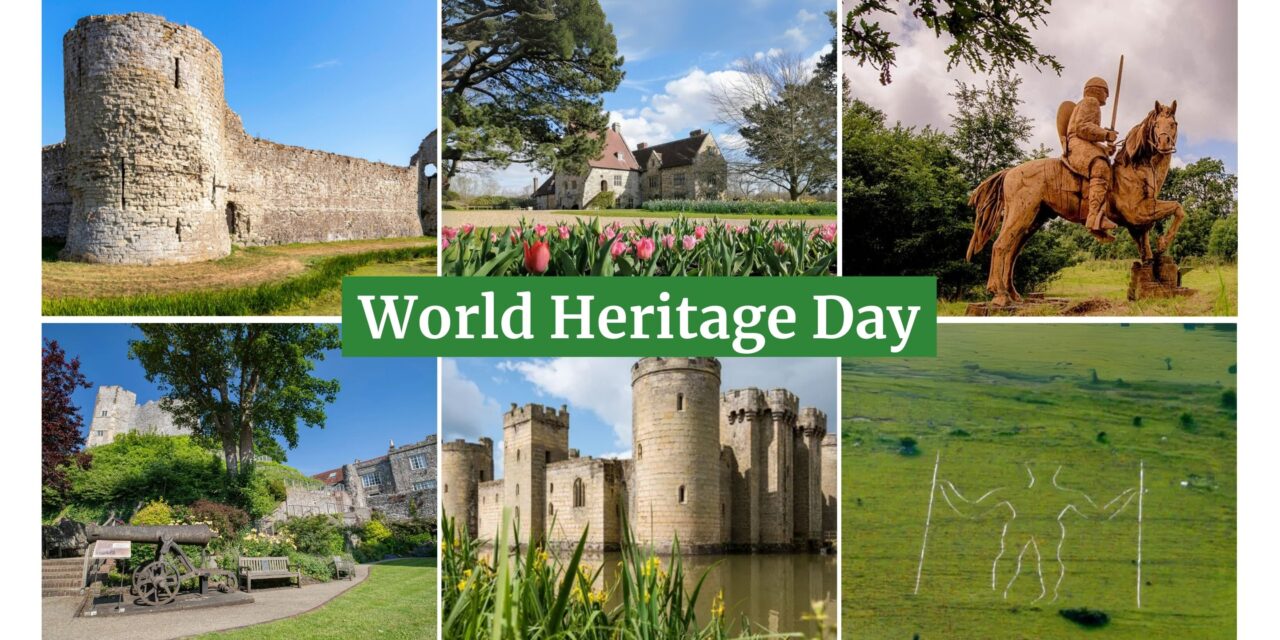When we think of England’s heritage sites our thoughts might turn to Stonehenge, Hadrian’s Wall or the Tower of London.
While these world-famous sites are incredible, we shouldn’t forget the amazing sites in East Sussex that continue to inspire, teach and entertain us in equal measures.
This article looks at some of those sites to mark World Heritage Day, or International Day of Monuments and Sites (IDMS), which is held annually on 18 April.
This year’s theme is “Heritage under Threat from Disasters and Conflicts: Preparedness and Learning from 60 years of ICOMOS Actions”.
While the sites we look at are not under threat from disasters, their histories tell the story of East Sussex, from the Norman invasion to a mysterious 72-metre-tall man.
1066 Battle of Hastings, Battle Abbey and battlefield
The Battle of Hastings in 1066 is one of the most famous battles in England’s history. As school children, many of us would have learnt about William the Conqueror defeating King Harold’s English army.
Battle Abbey, founded to commemorate the battle, is a great way to revisit those childhood memories – or even inspire your own children.
Re-discover the battle via interactive displays in the visitor centre, an audio tour, or by walking the battlefield, and hunting out wooden figures.
The abbey was founded by William and is believed to be in the exact spot where King Harold died. Inside the abbey’s gatehouse, an exhibition explores stories from its history.
A children’s playground inspired by the site’s history ensures there’s plenty for the whole family.
For more information visit 1066 Battle of Hastings, Abbey and Battlefield.
Lewes Castle & Museum
Did you know Lewes Castle was built by supporters of William the Conqueror following the Battle of Hastings?
Today, the 1000-year-old Norman fortress gives visitors a glimpse into Lewes’ past and panoramic views of the present-day town.
Visitors can climb to the top of The Keep and explore the castle’s history, which includes being the site of the 1264 Battle of Lewes. You can also discover the story of Lewes through a model of the town and a short film. And don’t forget to look out for talks and workshops held throughout the year.
The adjoining Museum of Sussex Archaeology has artefacts from prehistoric to medieval Sussex, plus temporary exhibitions.
Don’t forget to bring your picnic to enjoy in the lovely gardens.
For more information visit the Lewes Castle & Museum webpage.
Michelham Priory House & Gardens
If marching around castles and battlefields isn’t your thing, you can explore 800 years of history at the relaxing and picturesque Michelham Priory House and Gardens.
Set on a moated island, the House was founded in Upper Dicker by Augustinian priests during the 1220s. Destroyed during Tudor times, it became a home for evacuees and the Canadian Army in World War II.
Its rooms are designed to reflect different periods of its history. There’s hands-on activities and outfits for children to try on, and seven acres of grounds and buildings to explore, including an Elizabethan Great Barn, a medieval gatehouse and herb gardens.
You can also feed the resident ducks, hunt for sculptures in the grounds and let off steam at the children’s play area.
Learn more about the house and its gardens on the webpage.
The Long Man of Wilmington
Also known by the more magical name of the Wilmington Giant, this iconic 72-metre monument is steeped in history, and uncertainty. Who built it and when? Is it a fertility symbol, ancient warrior or an 18th century folly?
While we may never know the answers, the Giant has revealed some of its secrets to us, including:
- Roman-era coins found nearby
- The first illustration of The Long Man was drawn in 1710
- It was camouflaged during WWII to stop enemy aircraft using it for navigation
- In 1969 its outline was filled with concrete blocks to make it more visible. Its outline has been orange, red and yellow in the past
The figure is a popular destination for walkers and families and is free to visit.
Other heritage site to consider
These sites close during the winter and reopen in the spring, so do check opening times before you travel.
Anne of Cleaves House
Enjoy an insight into Tudor and Elizabethan life at Anne of Cleves House in Lewes.
Learn about Sussex life through a collection of historic domestic artefacts housed in the 15th Century timber-framed medieval house.
Anne of Cleves House opened on 1 April and remains open to 31 October.
Learn more on the Anne of Cleves House website.
The Priest House
The Priest House stands in a traditional cottage garden in West Hoathly. It’s former owners include: Henry VIII, Thomas Cromwell, Anne of Cleves, Mary I and Elizabeth I.
It is now furnished with 17th and 18th century country furniture and domestic objects
Learn more about the house on the Priest House & Gardens webpage.
Bodiam Castle
Bodiam Castle is a 14th-century moated castle with a ruined interior featuring spiral staircases, battlements and a portcullis.
Check the website for opening times and events such as family days, exploring the castle, have-a-go archery and much more.
Pevensey Castle
Pevensey Castle was started in about AD 290 and was the biggest of the Roman ‘Saxon Shore’ fortresses. Its walls, which are more than 500 metres (1,640 feet) long, still stand almost to their full height.
It was here that William the Conqueror landed to begin his invasion of England, building a fortress within the Roman defences.
After centuries of abandonment, the castle saw action again in 1940, with cleverly camouflaged machine gun posts installed into its walls.




